Media | Articles
Porsche’s first-gen Boxster is affordable top-down fun
Springtime has a funny way of playing with your decision-making skills, especially if you live up north. The thaw in 2014 began in late March, after a particularly harsh Northeast Ohio winter, and that first glimpse of warmth made up my mind: It was time to own a convertible again. That June, I brought home a 2001 Porsche Boxster S.
It wasn’t just the emergence from that year’s polar vortex and its negative temperatures that sent me hunting for a ragtop, however. I’d gone without open-air driving since 2006, when I built my road-going Miata into a race car. So I knew what all convertible people know: Once you get the bug, it’s hard to go without.
To be honest, the Boxster hadn’t even been on my radar. I’m not a Porschephile, and it was on a whim that I decided to take one for a test drive. The mid-engine induction noise seemingly plumbed directly to my ears was the first hint that the Boxster would be a good fit. That was soon followed up by gleeful discovery of the chassis’ poise; after catching an eager, cold-tire tail rotation with a flick of my wrists, I was smitten with the car’s balance and communication.

As I began searching for the right Boxster, that little buzzkill called rationality entered my internal chat. I heard it out. Yes, the intermediate shaft (IMS) issue—a bearing that is internet-famous for its potential to grenade these early water-cooled engines—was well-known by that point, but so were the signs and solutions. The “Porsche tax” on parts meant that there’d be a premium over the Miata parts I’d gotten used to buying. That said, a bit of research, knowing that I could perform most maintenance tasks myself, and the pull of that initial drive overcame any lingering doubts. I set about finding the best one I could afford.
My search took a while, and I drove several cars before settling on mine. Unlike prior Porsche models or more modern limited editions like the Boxster Spyder, there were plenty of pedestrian first-gen Boxsters out there to choose from. Before the Cayenne and Macan SUVs started printing cash for Porsche, the addition of the Boxster as a close sibling to the 996-generation 911 helped turn the company’s fortunes around. The first generation Boxster (986, in Porsche-speak) sold in droves, with 164,874 produced from its debut as a 1997 model through 2004. In its debut year alone, the Porsche sold 55,705 of them, beating the company’s 1992 total global sales by 40,000 cars. Porsche was well on the road to redemption by way of runny-egg headlamps and water-cooled sixes out back.
Marketplace
Buy and sell classics with confidence
In addition to the sheer number of Boxsters on sales lots, there was great variation in what was available, as Stuttgart incrementally improved its little savior over the years. Initially introduced with a 201-hp 2.5-liter flat-six, the base car’s engine got a 0.2-liter bump in displacement in 2000, upping horsepower to 217. The S was introduced in 2000 and included a 3.2-liter, 250-hp engine, six-speed manual transmission option (the base came with a five-speed, and Porsche’s Tiptronic torque-converter automatic was available on either trim), larger brakes and wheels, suspension tweaks, an additional radiator, and split exhaust tips. The updated “986.2” arrived for 2003, its most obvious changes including revised front and rear fascias, clear turn signals in place of the amber strips, and a glass rear window in the convertible top. The base car received tweaks to reach 222 hp, and the S got an eight-horse bump up to 258.
I found the ’01 Lapis Blue Boxster S you see here in Allentown, Pennsylvania. After viewing a wealth of photos and securing a clean bill of health via a detailed pre-purchase inspection from a local Porsche dealer, I flew out to pick up the car.
Since then, it’s been a joyous go-to, and the car I find myself choosing for short trips, or those golden hour just-because bombs through rural back roads. All of its attributes score well on their own, but the Boxster’s seamlessness is what sets it apart. Roll into the firm brakes (there’s always more on tap from that pedal), grin at the engine’s trademark scream through the heel-toe downshift, and feel the steering’s granular precision as it loads up on the dive into the corner. String a few of those moments together a couple evenings a week in the summer, and you’ve got a cure for most any woe.
Nearly as happily, over nine years and 24,000 miles, my Boxster S has been trouble-free. To be fair, though, it has required more than Toyota appliance-level maintenance. I’ve followed the prescribed schedule, including replacing items like the water pump, plugs and coils, and air-oil separator. I also added an LN Engineering oil filter kit for better filtration, and I send my oil out to the analysts at Blackstone Laboratories for testing with each change. Looking forward, at 22 years old and 77,000 miles, the car is about due for a suspension refresh.
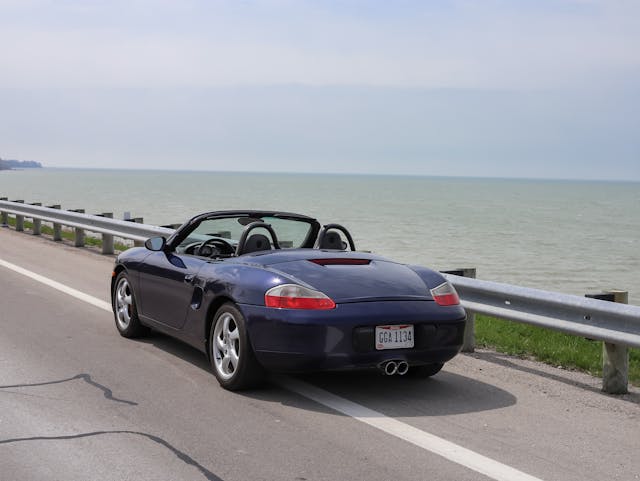
What’s not to like? Lest I come off sounding like these cars are trouble-free, I should stress that if you’re planning on buying one, find an example with good maintenance records. Once you own it, keep up with it. They can get expensive if you get behind on repairs. Do your research, too, as some engines are more reliable than others; early cars have a dual-row IMS bearing, for instance.
Porsche strangled these cars from the factory with tiny intakes and exhausts to keep them from nudging 911 territory. The sound, and a few ponies, can be freed up with updates like switching to the second-gen intake and a larger plenum and throttle body, along with an aftermarket exhaust.
Inside and out, the styling is an acquired taste. Personally, I prefer the 986’s lines to the more buttoned-up 987, though the interiors aren’t nearly as nice as newer Boxsters.
If you’re considering a convertible from this era, you have a few options, and it’s good to cross-shop—this hobby is about finding what you love, after all. Looking for nimble, crisp driving characteristics? The Boxster, Lotus Elise, and Honda S2000 all arrive at that target in different ways, each with its own personality. BMW’s Z3 in its various guises offers a classic roadster experience, though it isn’t quite as sharp or sporty. You could even toss in a fifth-gen Corvette convertible for kicks—it’ll handily outpace a Boxster S and offers its own glorious soundtrack, but it doesn’t feel nearly as alive when the roads get windy.
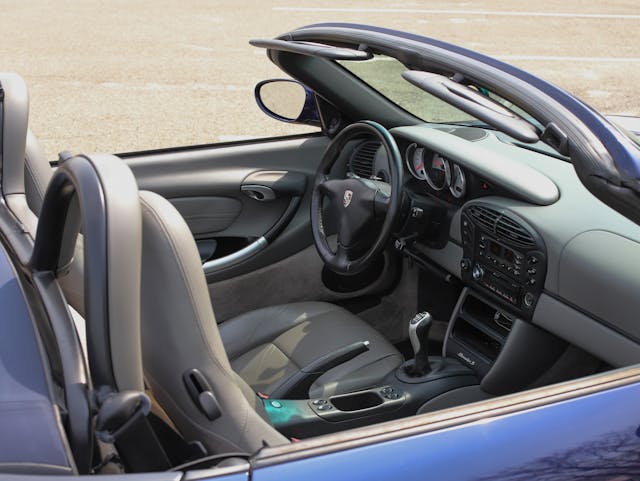
After sliding into a trough in 2017, 986 Boxster values have been on the rise. They’re still outshined in the market by their competition, with values of the aforementioned S2000 and Elise appreciating more rapidly. A few factors are at play, but you could argue that the Honda benefits from the current enthusiasm for Japanese sports cars, while the comparative rarity of the Lotus gives it a boost. Add in the love-it or loathe-it Porsche aesthetic of the era and concerns about reliability, and the Boxster’s trailing values start to make some sense.
Another factor in the Boxster’s slower appreciation is its interest across demographics. Boomers lead the share of insurance quote data on these cars, with 47 percent of quotes sought. That outstrips their overall market share by over 13 percent. Gen X makes up 30 percent of quotes, effectively tracking with their share of the market. Millennials and Gen Z pay comparatively little attention to the first-gen Boxster, which may tamp values in the longer term if trends remain the same.
You can still find a good driver-quality 2000–02 Boxster S for under $20K, which represents a tremendous value for the experience. The 2003–04 models will fetch a few grand more, and the added tweaks like the glass rear window that comes with the later models are more sought-after. While other convertibles from the era continue to appreciate, and younger buyers are flocking to BMWs from the early 2000s, attention for the 986 Boxster is steady at best, a bit wanting at worst.
From my perspective, that’s OK. I know my car’s never going to be an expensive collector piece. That frees me from worrying about where to park it and enables me to perform minor upgrades without concern for absolute originality. I bought this car for how it makes me feel, and for the fun of using it and working on it. If you go about your car purchases the same way and find yourself itching for some top-down fun, give the 986 Boxster a look.
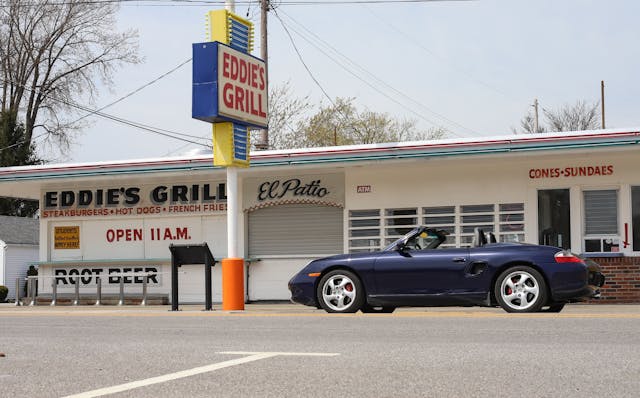
***
Check out the Hagerty Media homepage so you don’t miss a single story, or better yet, bookmark it. To get our best stories delivered right to your inbox, subscribe to our newsletters.
Via Hagerty Insider
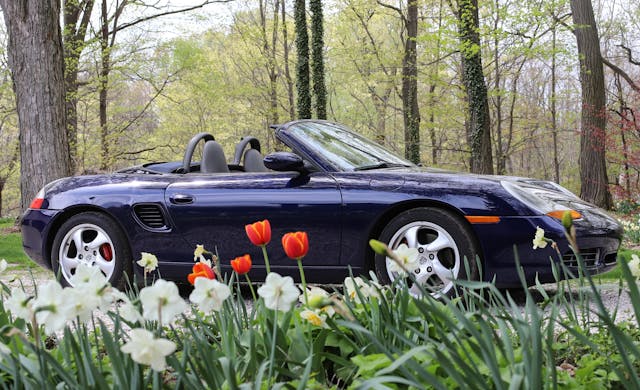
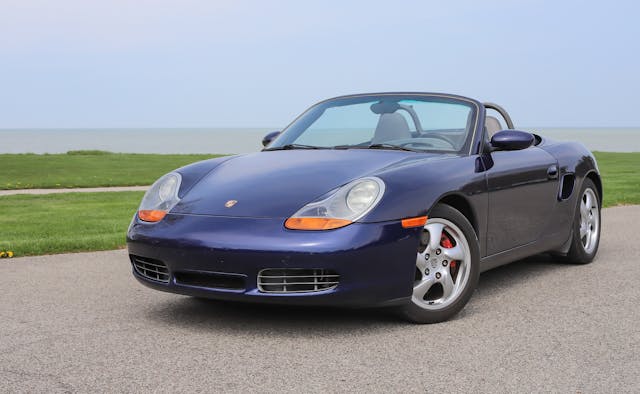







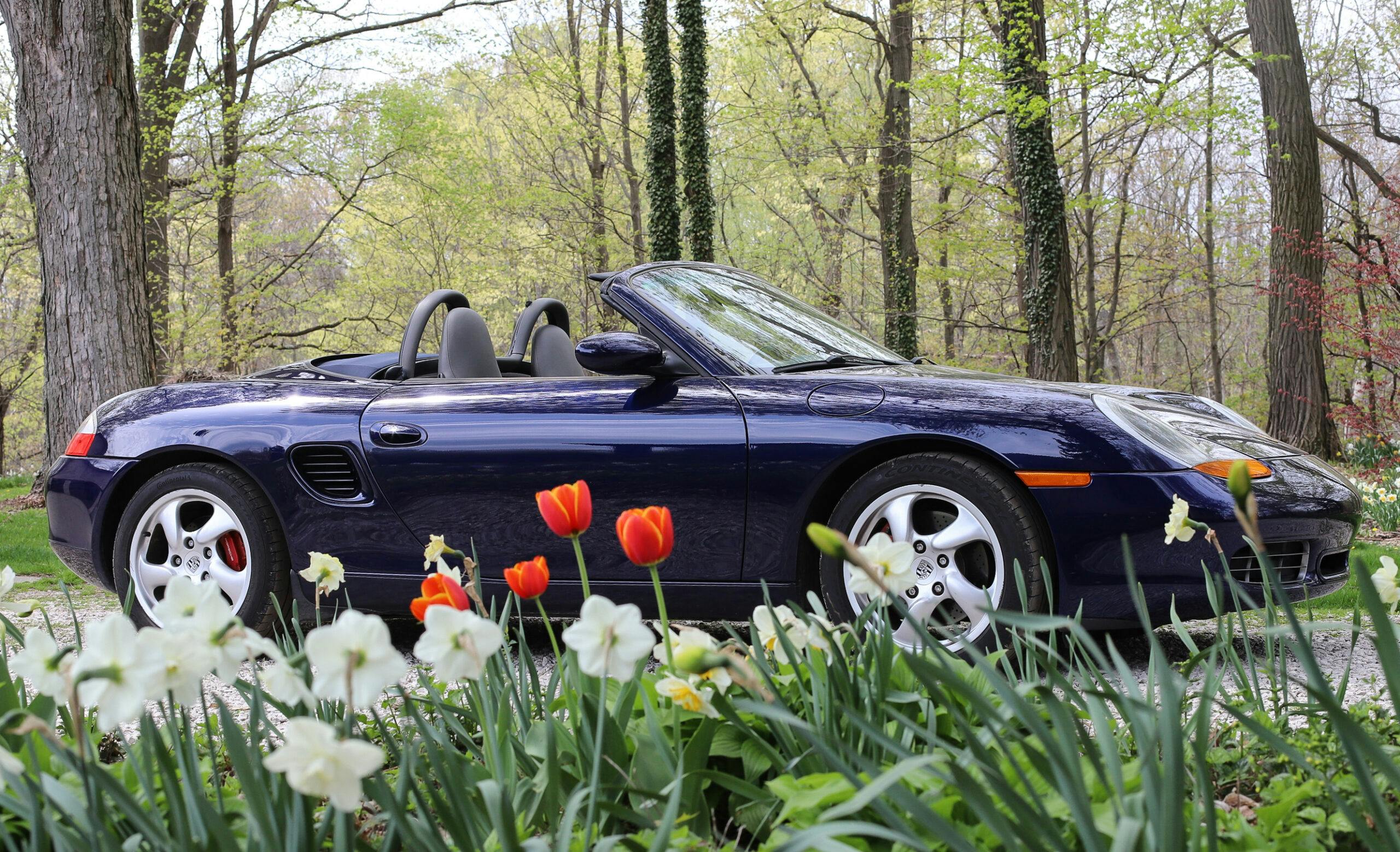
I have nearly the same car as yours–mine is an ’02S, also in Lapis. I love it,. I’ve had it for a couple of years and last year took it on a 4,000-mile road trip down the coast from Washington to LA, thence to Phoenix, and then north through Utah, Idaho, Oregon, and back to Seattle. The car was nearly flawless, and was way more comfortable then I expected, even with the top down at 100 mph through Utah.
I’ve had a few well-documented problems–the section of top above the rear quarter windows jumps the track (a common problem) and the driver’s side window lost the feature that lowers the window a smidge when you close the door stopped working, requiring that I replace the latch mechanism. And the water pump failed during a family trip. OK–it’s had a few problems, but, in fairness, it’s over 20 years old.
The previous owner replaced the clutch, upgraded the IMS bearing, and installed a gorgeous full-length Fabspeed exhaust system. I’ve added a new soft top with a glass window. When the weather and the road are right, there’s no better ride in my experience.
My son bought a Boxster. Bad IMS bearing. He got rid of it.
If you can find one that has been repaired and is in good shape it is a good car.
But I chose the C5. The price of parts is very cheap. Easy to work on and easy to make more power should I chose. The platform is also stiffer. Right now prices are just going up so good buys are still around if you shop smart.
As for sound nothing beats a V8 thunder. Mine has a Borla that is quiet driving around but add RPM and it can sound like the C5.R at LeMans.
Though I do not have a power top it is a very easy top to operate.
The C5 and later cars are not the same Corvette of the past. No rattles and just a good solid platform.
hyperv6: My dad has a 2000 C5 convertible with a manual. They’re a blast, and a good choice in this segment.
I owned a C5 convertible for many years. Fast, comfortable and reliable. Prices for C5’s are reasonable now as they were built for several years, and there are plenty available.
These cars have been nipping at my consciousness ever since I was shopping for a Miata in 2011. Never having driven one, I can only imagine that the handling balance and long-legged performance would make it a fun toy. If all out track speed is the goal (and it certainly doesn’t need to be) a Corvette does seem to be the better value.
At the time I wasn’t ready for the maintenance cost and complexity – something that ruled out the RX-8 as well – so I wound up with my ’99 Miata. The performance gap is no doubt large, but the Miata has been a pleasant, engaging, low-cost ownership experience these past 12 years. I even was lucky enough to be invited to attend a Porsche group’s track day at Circuit Mont Tremblant last year and had a blast. Although the lap time gap between my car and the Porkers was enormous, even my friend, who drives a track-prepped 944 Turbo, admitted that the go-cart nature of my little car was charming.
TalkingPie: I agree. My Miata remains my go-to for track work because of the maintenance/reliability/cost scenario. It doesn’t hurt that it’s incredibly fun in its own right. It’s also an excellent choice on the street for the same reasons.
We are a Porsche family; 993, 996 and 2001 Boxster S. Had the 996 since it was 2 years old, always wanted and air cooler but in the middle of winter, I tend to think of driving the Boxster and that is the one I use the most. I’ve had an S2000 and just sold our Elise SC, and I will say the Honda is probably my favorite in the segment. The Boxster S though, is close to perfect for what it is and very easy to live with. Outside of upgrading the IMS, ours has been relatively free of major work, but you must keep up with the maintenance. Find a low mileage good one, get a PPI and have fun!
I was living in Santa Cruz and commuting daily over the hill to Silicon Valley when it occurred to me that this situation really required a Porsche. Picked up an ‘03 Boxster S on what after a few 911’s felt like on the cheap and I was set. My morning drive on curvy high speed Hwy 17 at 5:30 am was pure pleasure with the goal of making the downhill side without touching the brakes regularly achieved. And after a typically ridiculously long day, the drive home often moved to winding Hwy 9 through the redwoods to avoid the inevitable overturned tanker back on 17. Heaven.
A bit later we moved to Los Gatos and the Boxster’s work was done. A toy car now made sense instead of a commuter and I picked up a 911SC for basically what I got for the Boxster. The very definition of the good old days. I’m definitely an air cooled 911 guy, but as a daily driver the Boxster S was pretty hard to beat.
Great Flat 6 sounds.
When you get ready for your suspension refresh give a good look at the ROW M030 suspension kit. I did one on my 2001 Boxster and it was transformative. The car went from a very nice handling car to a superb handling track machine while remaining very comfortable on the street.
Bill, Funny you mention that– I have just begun taking a look at suspension. Definitely planning on the ROW 030 bars, but I haven’t yet decided if I want to go oem shocks or koni yellows.
If you are willing to deal with a high mileage car, Boxsters can be had at $10K or less, serious fun for the dollar. I picked up a base ’98 in March of 2022 for $6700. It’s got 140K on the clock and came with a decade plus of maintenance records. When I was looking, I mentioned that I was coming off a high mileage E46 coupe and someone on Rennlist said if you survived that, a Boxster will be a cake walk. He called it the Toyota Corolla of Porsches, which may be a stretch but makes the point.
It badly needed struts, so I’m putting on a set of Koni reds. Right now it needs a starter, but I enjoy doing the work so that’s OK. The Porsche parts tax is real, a set of Koni reds for my E46 was something like $400, the Boxster set was $800 after 20% off.
@salguod, I’ve enjoyed Konis on a few cars and have been debating picking them up for the Boxster. I hope they work out well for you!
I too bought a high mileage (120k) but well maintained and documented 2001 Boxster S. Car had very little mileage over last 10 years but still had oil changed annually by a Porsche specialist. IMS done with clutch. High option car in rare color with factory hard top. Needed tires as it came with brand new but 10 year old rubber. So far, an amazing car. It goes to a dedicated Porsche shop (Ralphs) and they can’t find any issues. I did a modern stereo with back up camera. $12k in and I am one happy driver. Just ask the Blueridge Parkway! Happy driving!
Picked mine up on BaT after my 996 was totaled by a young driver. PO has owned many Porsches and took great care of it. Wanted back into a Porsche but interested in the mid engine experience. Love the looks more than the 996 now that I’ve owned both. My first test drive the tail came out in hard accel turning onto twisty road. Quick intuitive corrections brought it back in line with no drama and the wife was impressed. She autoX’s a Miata, me a handful of other cars. Anyways, doing full suspension resto with GT3 bits and Ohlin’s for autocross and lapping season and can’t wait. Deeper baffled oil sump pan and better bucket seats and should be well on my way. Surprisingly easier to work on than my 996, much less prone to bore score due to diff piston materials has me driving with more peace of mind. Factory hardtop really improves the experience when I don’t want top down. In love 🙂
I own a 99′ 986, bought it new 26 yrs. ago. I have not had any major issues with the car, just basic things that you replace on any older car. Next week I am changing the exhaust clamps and rear lower control arms. In the spring I will be putting a new set of Michelin Sport Pilot tires. Parts are not cheap, but compared to the price of new Porsche’s, I think it’s a steal. Still love driving the car.